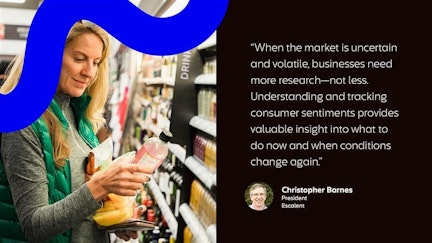Perspectives

Whether it’s trade tariffs changing daily, demand shortages in the supply chain or war, there is no doubt that brands are living in a volatile, uncertain, chaotic and ambiguous world that requires insights professionals to support their businesses in ever more nimble ways.
On the one hand, you need to ensure that you are listening and perhaps helping brand loyal consumers. The last thing any business wants to do is lose loyal customers who may already be struggling to stay ahead of the tide of rising costs for everything they purchase. They may have fluctuating feelings of fear, concern, or discomfort about the world we are living in.
On the other hand, keeping ahead of the waves of changing costs requires agile management of price and demand elasticity.
Navigating this tightrope is tricky, but not impossible. Ultimately, it has never been more important for brands to demonstrate consumer empathy and show they understand the sentiments of their customers. Only by showing you understand will you have any chance of increasing loyalty and gaining share from competitive brands that may not listen or understand their customers as deeply.

Insights and marketing professionals play a crucial role in analyzing consumer sentiments, managing the customer loyalty journey, and helping keep brands on the path to growth, despite the misty seas of change.
We’ve created a handy checklist for you to ensure that you are optimizing customer understanding and delivering impactful insights that can help guide your business to stay ahead of the competition.
1. Customer empathy
Are you aligned with what your customers are feeling and needing? If you haven’t taken the temperature of how your target customers are feeling in a while, then the chances are that your brand messaging could be off.
Brands are a comfort blanket to consumers in times of turmoil, so you should ideally avoid looking like you aren’t listening if you want to show that you know your customers and care about them to maintain loyalty.
2. Don’t face the fear in the dark, monitor consumer sentiments to stay ahead
Navigating consumer sentiment without a brand tracker is a risky strategy. Monitoring the pulse of consumer sentiment is one of the most important investments brands can make.
What emotions are dominating consumer mindsets? Is it fear, optimism, anxiety; all of them or none of them?
Only by understanding these shifting emotions can you build reassuring, resonant messaging into your communications as a response.
Is buying sustainably less important or no longer important at all? Are they shopping differently than normal? How important are loyalty points? Do they want money off or rewards such as free coffee?
How easy is it to access price savings and rewards? For example, when I buy coffee out of home I am influenced by how easy it is to access my points for a free coffee?
Review how your messages are landing — and what’s falling flat — to stay trusted and relevant.
3. Prioritize what matters most: Decision tree analysis and always-on research
A decision tree analysis will help you understand the layers of what will influence purchase or non-purchase. With so many emotions at play, it is likely that consumers have changed in what’s most important to them.
Which attributes – such as trusted brand, affordable and good value, makes me feel good – matter most among consumers while preferring a brand.
It’s worth considering an ‘always on’ approach to research. The world seems to be in a state of permanent flux, which means consumer sentiments are too. The last thing any brand wants is to be seen as tone deaf. Keeping your finger on the pulse continuously is critical.
4. Review your brand tracker to confirm you are asking the right questions
There are many business decisions that can be influenced by such insights: price increases, product innovations, marketing campaigns, and more.
If you already have a regular tracker, take a look at the questions. What are you not asking? What should be adjusted to get a better read of sentiments as it relates to your brand?
We know that people are afraid of uncertainty, but how does this impact their relationship with your category and brand? How can you reassure them?
5. Adapt Price and Demand Elasticity studies for fluctuating consumer demands
If it’s been a while since your last price sensitivity study, then it’s definitely time to review this now; ideally before any urgent price changes are required. It’s as important for price inelastic brands as it is for price elastic brands, particularly since it’s likely that your sensitivity has shifted.
Consumers are likely to be more price sensitive, but this will vary by category and needs to take into account the ‘I need a treat’ factor as consumers crave moments of indulgence regardless of the price.
When you’re making price increases, it’s not always necessary to justify them. When consumers understand more broadly the economic conditions such as newly imposed price tariffs, they understand. None the less, identifying how the price of your brand will impact demand in a stretched economy is a useful analysis that can be leveraged across the organisation.
You could include analyzing shifts in shopping habits to proactively adjust promotions, placement, and messaging. Identifying the point where demand falls off a cliff ensures that executives are armed with critical information to make fast decisions in response to changing market conditions.
The critical importance of insights to drive action
Being as close as possible to consumers may very well be more important than ever. Brands have navigated a myriad of economic crises, crashes and recessions over the decades, but the world in 2025 is very different.
Prices continue to rise across product categories; people are uncertain, even fearful of what tariffs, change driven by AI and the ongoing threat of unemployment will actually mean to their daily lives. Brands must be sensitive to consumer feelings and priorities in this tenuous environment.
Insights ensure marketing and innovation investments are focused on what truly matters to consumers, reducing risk and maximizing impact. Ultimately, insights empower brands to make faster, smarter decisions with greater confidence. They will drive brand and even business decision-making in a timely, ongoing window to what consumers need.
Talk to our team of experts
Learn how we can deliver actionable insights and creativity to drive brand growth.








